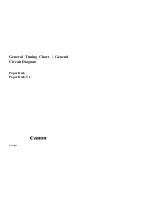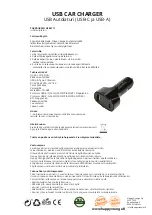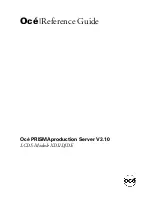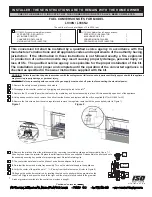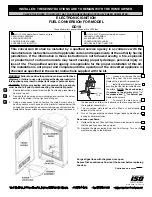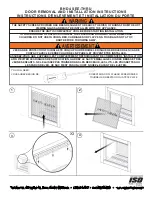
3
1.
Drive the vehicle within three or three-and-a-half feet of
the motorhome hitch receiver. The vehicle does not have
to be perfectly centered to the hitch receiver, just close.
Then, put the vehicle in gear (park), set the emergency
brake and chock one of the wheels.
2.
With the tow bar in the folded position (Figure 2), insert
the stinger into the motorhome hitch receiver and secure
it with the hitch pin and clip (Figure 2).
3.
Hold both tow bar arms firmly and rotate them up, so
that they are vertical, as shown in Figure 2.
Never release the tow bar arms when they are in the
vertical position. The arms can fall and cause severe
personal injury.
4.
Push the release latch
(Figure 3) forward, to bring
both arms down to a horizon-
tal position.
Standing to one side,
swing both arms away from
you. Then, align the holes in
the outermost arm with the
holes in one of the tabs on
the baseplate (Figure 4 — next page).
Attach the tow bar arm to the baseplate with one of
the included base pins (Figure 4). Attach the arm so that
the head of the shoulder bolt (Figure 4) is facing up. Lock
the base pin with a linch pin (Figure 4) or optional padlock
— part number 301 (one padlock) or 302 (two padlocks).
The linch pin must be
locked. The ring (Figure 4) is
CONNECTING THE TOW BAR
Figure 2
Use caution when handling the tow bar — if your
hands, fingers or any part of your body are caught
between moving components, they can be pinched,
cut or otherwise injured.
Figure 3
spring-loaded — it must be snapped over the pin, as shown
in Figure 4, with the curved side of the linch pin touching
the ring, in order to keep the base pin secure.
Both tow bar arms must be attached to the baseplate
and locked with a linch pin. Towing vibrations will
force the linch pins out unless they are properly locked
in place over the base pins on both baseplates.
Failure to properly install and lock both base pins
will result in the loss of the towed vehicle, which may
cause property damage, personal injury or even death.
5.
Now, swing the other arm to the opposite side and
connect it in the same manner.
CAUTION
Attach the tow bar so that the release handles and
the release latch are pointing up. Components of the
tow bar may be damaged if the tow bar is attached with
the release latch or the locking mechanisms pointing
down.
6.
Attach the safety cables and plug in the electrical wir-
ing cord, according to the supplier’s instructions.
Before towing the vehicle, be sure the steering is un-
locked, the transmission is in the proper setting and the
emergency brake is released. Remove the wheel chock.
Check the owner’s manual for the proper towing
procedure(s) or requirement(s) for towing.
Do not tow the vehicle until the tow bar is attached
with all pins or padlocks. Unless the tow bar is se-
cured to both vehicles with all appropriate pins or
padlocks, the vehicle will detach, which may cause
property damage, personal injury or even death.
7.
When you drive away, steer briefly to the left and then
to the right, to extend, self-center and lock each tow bar
arm.
Always stop at this time. Check the tow bar to ensure
that both arms are locked before towing further. Addition-
ally, check the other components of your towing system.
Both tow bar arms must be locked before tow-
ing. If they are not, the momentum of the towed ve-
hicle will apply excessive force to the tow bar arms
and other components of the towing system, which
may cause the towing system to fail, resulting in
property damage, personal injury or even death.













